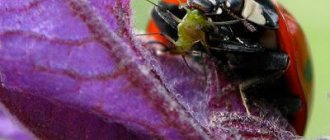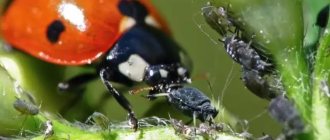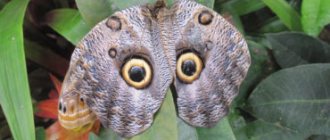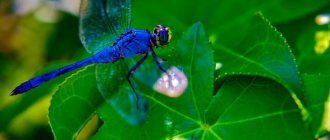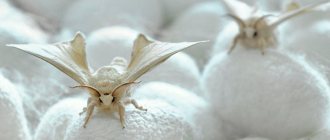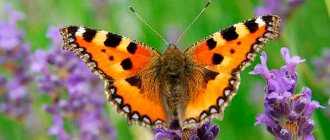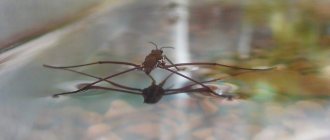The ladybug is an arthropod insect that belongs to the order Coleoptera, the ladybird family (Coccinellidae). The ladybug received its scientific name due to its unusually bright color - the Latin word “coccineus” corresponds to the concept of “scarlet”.
And the common nicknames given to the ladybug in many countries around the world speak of people’s respect and sympathy for this insect. For example, in Germany and Switzerland it is known as the “Virgin Mary’s bug” (Marienkaefer), in Slovenia and the Czech Republic the ladybug is called “Sun” (Slunecko), and many Latin Americans know it as the “St. Anthony’s bug” (Vaquita de San Antonio).
The origin of the Russian name for ladybug is not exactly known. Some researchers are inclined to believe that this is due to the ability of the insect, in case of danger, to secrete “milk” - a special poisonous liquid (hemolymph) that repels predators. And “God’s” means meek, harmless. Others believe that these insects received the nickname “ladybugs” because they destroy aphids and help preserve crops.
Development cycle
Most ladybugs reproduce in the spring or fall. Female ladybugs, depending on the species, lay from 3 to 300 eggs. The eggs are laid near aphid colonies. Larvae from the testicles of the two-spotted ladybug usually develop within 5-8 days. The larva eats 350 to 400 aphids daily and reaches maturity in 10 to 15 days. Then it turns into a pupa, and its cocoon usually hangs in clearly visible places.
The conversion cycle lasts from 4 to 7 weeks. In the temperate zone, young and adult individuals hide in the cracks of trees or under their bark for the winter.
Every few years, in the summer, the beaches are strewn with seven-spotted ladybugs. This happens because they don't have enough aphids. For this reason, they are forced to migrate in search of food. At this time, they are so hungry that they bite everyone - even people - to see if they are suitable for food.
Reproduction of beetles
Between the third and sixth months of existence, individuals reach sexual maturity. Their breeding begins in mid-April. At this point, they are gaining strength after hibernation or migration. A male can recognize a female by the special smell released during the mating season.
The eggs are laid by the female near the aphid colony. This is done specifically so that the offspring are provided with the necessary nutrition. The oval-shaped eggs are attached to the underside of the leaf. Their surface is wrinkled and painted white or yellowish. One clutch can contain up to 400 eggs. Unfortunately, at the end of the mating season, the females die.
Variegated larvae appear after a few weeks. They are flat or oval in shape, and the surface of their body is covered with finely structured hairs or bristles and marked with a pattern of white and orange spots. In the first days of life, the larvae feed on the shell of the egg from which they emerged, and a little later they begin to eat other insects, in particular aphids.
After the larval stage, which lasts from 4 to 7 weeks, the pupa is formed. It is attached to plant foliage by means of an exoskeleton. During this period, the laying of insect body parts is carried out. After 7 days, an imago appears, that is, an adult that is fully formed and ready for life.
Benefits and harms
Predatory beetles are quite voracious, and this is of unconditional benefit to people. They spread quickly on crops in gardens. They also inhabit cultivated trees in human gardens. There is evidence that the larva can destroy up to 50 individuals of harmful parasites per day, and adults eat twice as much. People have long noticed this feature and are specially breeding populations of beetles on farmland. This measure is considered effective for clearing plantations and fields of pests.
But there are also herbivorous species. They live in the tropics of southeast Asia. These types of ladybugs are known to cause significant damage to crops. In Russia there are several representatives of the family that attack tomatoes, potatoes and cucumbers. Certain species happily eat sugar beet shoots .
Location
Ladybugs live all over the world, but are more common in the temperate zone - in Europe and North America. It is relatively rare to be found in tropical forests, where many other species of beetles live.
Most often, these insects live in environments modified by humans: in gardens, forestry or abandoned areas overgrown with weeds. Aphids, which are the main food of ladybugs, live in large numbers in these areas. In addition to aphids, ladybugs feed on other insects: scale insects, whiteflies (aleurodids), spider mites, etc.
There are also species that feed exclusively on plants. In the UK, ladybirds are grown to protect gardens from aphids. On all continents they are bred to combat garden pests.
A good example of this is the rhodolia ladybug, brought from Australia to the USA to exterminate scale insects (close relatives of aphids) - insects that cause great harm to local citrus plantations.
Features of character and lifestyle
Photo: Red ladybug
All varieties of ladybugs choose an isolated lifestyle and form groups only for flying to warm regions or wintering in a secluded place. These huge groups can number up to 40 million individuals. You can also notice clusters of bugs during their mating season. All these bugs do not hesitate to feast on the larvae of their relatives, but only in the absence of a sufficient number of aphids and other food. But there are varieties of ladybugs that purposefully destroy their fellow creatures.
Interesting fact: The yellow marbled ladybug was specially bred as an effective biological weapon against agricultural pests, but it was because of it that some varieties of these bugs were in danger of complete extermination, since the marbled ladybug destroyed them in huge quantities along with other insect pests .
These insects are active all day, they slowly crawl from one plant to another in search of food. Given enough food, the lifespan of some individuals can reach two years or even more, but this happens extremely rarely. The main part dies much earlier, before reaching the age of one year, and there are many reasons for this: from lack of nutrition to environmental pollution.
What does it eat?
Most ladybugs feed primarily on aphids. Aphids are soft-bodied, defenseless insects that suck juices from plants. Some types of ladybugs eat scabies mites that harm plants.
Aphids are slow and weak, so the cow does not need special devices to hunt them. The larva of this beetle eats more than the adult, and if there is a lack of aphids, it can feed on other larvae. The jaws of the larvae are the same as those of the adult.
The main enemy of aphids is the ladybug, its stages of development
Last time I talked about aphids and showed a photo of them. Today's story is about the main enemy of aphids - the ladybug . Everyone is familiar with the appearance of this bright red beetle with black dots on its back, but not everyone knows what its larvae look like, which are no less important, and are sometimes destroyed due to some similarity with the larvae of the Colorado potato beetle. Today I will show you what a ladybug larva looks like, how it grows, molts, how it eats aphids, pupates, and what hatches from it. I will show different types of adult ladybird beetles: the seven-spot ladybird (lat. Coccinella septempunctata) and the two-spot ladybird (lat. Adalia bipunctata) and tell you how they differ.
The ladybug is perhaps the most widely known beetle. Every child knows him. And most people are quite happy with this common name for dozens of species of ladybugs, quite different in appearance, which make up an entire family of beetles with the Latin name Coccinellidae .
Ladybugs are small insects well known for their bright colors and lack of fear of humans. Most people are familiar with the seven-spotted ladybug , but the species diversity of these insects is enormous. There are 5,200 species of ladybugs in the world, classified into the family of the same name in the order Coleoptera. Thus, numerous species of beetles are relatives of ladybugs.
What does a seven-spotted ladybug look like?
Seven-spotted ladybug (Coccinella septempunctata L.) This almost round beetle with red elytra and black dots on them is affectionately called in Ukrainian villages - the sun. Indeed, the ubiquitous inhabitant of fields, meadows and gardens cannot but arouse sympathy. For many, it is associated with childhood memories; many have at least once held it in their hands and watched how, having climbed onto their finger, the bug spreads its wings and flies “to the sky.” But entomologists know very well that the peacefulness of this ladybug is just an appearance. In fact, this is a real predator. He is constantly in search of more and more new victims, which he greedily eats.
Her elytra are bright red with black spots. Everyone remembers this. 3 on each elytron and one common subscutellum - seven in total. Upon careful examination, we see two more whitish spots: they are located on the forehead. The body length of beetles can vary: from 5 to 8 mm. This does not mean that a small beetle is young and a large one is old. It’s just that in the first case, the larva from which the beetle was formed clearly did not finish eating, it was simply starving. And in the second, she ate her fill. So the result turned out different.
What does a two-spot ladybug look like?
The two-spot ladybird differs from it in appearance . Ladybug is very variable in color. Usually the elytra are red, each with one black spot. They can be completely black or black with 2-3 red spots on each elytra. The pronotum in light forms is yellow with an M-shaped black spot, in dark forms it is black with yellow or white sides. The legs and chest are black, sometimes brownish-black in light forms. The mouthparts and antennae are yellowish-brown. Body length 3.5-5.5 mm.
The species is very common in Russia. It is found in fields, gardens, parks, forest belts, and less often in forests. The beetles overwinter in the litter in the same places where they develop in the summer. Sometimes hibernating beetles are found in crevices in the bark of trees. They appear earlier than other types of ladybugs; already in the second half of March it can be found in an active state.
During the season, the two-spot ladybird undergoes a change in biotopes. In spring and early summer, it is found mainly in orchards, where it feeds on apple, peach and reed aphids, and also settles on other tree species. The species is very rare on herbaceous plants of this time. From mid-summer, when the number of aphids in gardens decreases, beetles disperse more or less evenly on grasses and trees in search of food. At this time they are found on cereals and other field crops.
How does a ladybug develop?
On the underside of the leaf, the female lays her orange eggs in clusters of up to fifty in each. Just one female can lay up to 600 eggs. After one to two weeks, agile black larvae with yellow spots, 2-3 mm in size, emerge from them. While still very young, they already show their predatory nature and attack all living things that they see around them. Naturally, during this period, the victims correspond to the size of the predator: usually these are aphid eggs or their newly born larvae.
A month later, having destroyed many aphids and reached a length of a whole centimeter, the larva immediately in the feeding zone turns into a black, motionless pupa. And after another week and a half, a bug emerges from the skin that is cracked along the back. Having rested a little and waited for his elytra to thoroughly harden and become stronger, he realizes that he is hungry and begins to search for food.
The photo shows the molting of a ladybug larva. She sheds the exuvium (old skin) and underneath it is a new skin of light gray color. Insects have an external exoskeleton and are forced to shed the old small one, growing a new large one as they grow.
Ladybugs try to lay eggs near clusters of victims (aphids). Thus, the larvae of ladybirds are provided with food from the first minutes of life, however, finding food for them is not difficult, since the larvae are mobile and run quickly. The larvae are small, with an elongated, segmented body; some species may have branched outgrowths. The color of the larvae is gray (less often yellow) with yellow or red dots. The larvae are as voracious as their parents and can even attack prey that is larger than them. Their development lasts from 2-4 weeks to 3 months, during which time each larva can eat up to 1000 aphids.
The larvae of the two-spot ladybird are campodia-shaped. The head is yellow, only its lateral parts are black. The thoracic segments are white with black scutes. Abdominal tergites are brownish with a small white spot in the middle of almost all segments. The median parascolia on the fourth abdominal segment, as well as the space between them, are orange. This feature is clearly expressed and characterizes the species well. The length of the fourth instar larvae is 5.2-8.2 mm.
What do ladybugs eat?
The vast majority of ladybugs are voracious predators and only a few species are herbivorous. Predatory ladybugs are extremely voracious and can eat up to hundreds of small insects per day - aphids, spider mites, scale insects, whiteflies, and they prey not only on adult individuals, but also eat their larvae and eggs. Occasionally, ladybugs can even attack butterfly caterpillars. The victims of ladybugs are inactive, so hunting for them comes down to simply eating the victim.
Enemies of ladybugs
Ladybugs themselves have few enemies. Of course, they get in the way of birds, but they have an effective means of defense. From the joint of the legs they secrete a pungent yellow liquid with an unpleasant taste, so birds and lizards more often spit out the caught bug than eat it.
In the photo, a ladybug larva with black spines and yellow spots is eating a winged aphid.
Ladybugs have been respected and loved by people since ancient times. Among all nations, these bugs were considered a symbol of goodness, prosperity, and gullibility. Interestingly, in 55 world languages there are 329 names for these insects, one way or another connected with the concept of God! These insects are called “ladybugs”, “lady sheep”, “lady cattle”, etc. The English name (literally translated "Virgin bird") refers to the Virgin Mary.
And this connection arose thanks to seven points on the back of the most common species - the seven-pointed ladybug. The British interpreted the red color of the ladybug as a reminder of the passion of Christ, and seven black dots were associated with the seven sorrows of the Mother of God. Ladybugs have been a favorite object of children's folklore, because they willingly land on hands and clothes, and are accessible to observation even by the smallest naturalists.
In the photo, a ladybug larva is examining a leaf for the presence of aphids. It would seem that here she is, green, sitting, but the ladybug larva is looking for something on the other side of the leaf.
And for good reason. There is no living space on the underside of the leaf because of the aphids that have attached themselves to the veins of the plant. A noble feast awaits the larva!
When the ladybug larva has grown sufficiently and stored nutrients, it is time to metamorphose. She once again sheds her skin, attaches herself to some leaf with the back of her body, and turns into a pupa. After some time, the familiar red beetle with black dots will hatch from it.
What are the benefits of ladybug?
Now these peaceful and beautiful beetles continue to serve people. Ladybugs are used on an industrial scale to control crop pests. Farmers all over the world are happy to see ladybugs in their green spaces; moreover, there is a practice of importing large quantities of these beetles to many countries as a natural regulator to control various types of aphids. Pest control is the main task of two-spot beetles, as it helps reduce the total number of affected plants.
There is an interesting story connected with the seven-spotted cow. Knowing about its amazing gluttony and the enormous benefits it brings by protecting plants from aphids, American entomologists decided to bring (as they say in such cases, introduce) it to North America. They rightly believed that if this species acclimatizes, that is, adapts to the American climate, begins to reproduce and spread independently, local farmers will receive an excellent free assistant in the fight against harmful insects. The cows were caught in the thousands in Europe, placed in special container boxes and sent to the USA. There they were released everywhere, believing that they themselves would choose the most suitable places of residence. This went on for many years. And all to no avail. It must be said that not every introduction of a beneficial insect, as well as other animals and plants, is easy. Sometimes all efforts end in failure, and the efforts are wasted. In other cases, acclimatization takes many years. But this is what finally happened to the seven-spotted ladybird.
Desperate American entomologists were already ready to abandon this idea, when one day a New York nature lover brought to the entomological museum a beetle he had caught that had never been seen on the American continent. Imagine the surprise of the specialists when in the “foundling” they discovered one whose introduction and acclimatization had taken years and a lot of money. When investigating the story of the capture of the beetle, it turned out that it was found near the main airfield of New York. We began to explore its surroundings and quickly discovered a huge number of these beetles. They settled well here and ate with appetite their exotic food—North American aphids. It turned out that a large batch of Christmas trees imported from Europe, which had become unusable during the long transportation, had somehow been dumped near the airfield. Most likely, the cows were accidentally brought in with them. In one of the European countries, they settled down for the winter in the midst of these pre-prepared fluffy Christmas trees. But instead of calmly waiting for the arrival of spring, we unexpectedly found ourselves overseas. Here they had no choice but to wake up in a warm climate ahead of schedule and begin feeding and reproducing.
Where is it found?
Ladybugs can be found throughout the year (for example, if you dig up the dry leaves under which they hide during the cold season), but you can see them without making any effort only in spring, summer and early autumn. In winter they hibernate. At this time of year, entire groups of ladybugs protect themselves from the cold in secluded places, for example under the bark of a tree.
In summer, they can most often be found on roses, cherries and other garden plants affected by aphids. Taking a closer look at the plants, you can see the testicles of ladybugs. Ladybug larvae live openly on plants. In winter, you can find the seven-spotted ladybug among the needles of coniferous trees.
Insects feeding on bed bugs
There are many predators that eat bed bugs. Let's look at whether they might be useful to you.
Red cockroach
When you see a cockroach briskly moving around your kitchen, it means that you have problems in the form of yet another unwanted tenants.
When it comes to the cockroach menu, the question is not what they eat, but what they don't eat. Answer: Cockroaches are omnivores and eat everything around them, including plants and other insects. That's why they also eat bed bugs.
House ants
You should know that there are thousands of varieties of ants, and depending on the type of ants, bedbugs are susceptible to their aggression.
Ants are also omnivores and eat many things they find around them, including seeds, plants or insects. In their natural habitat, ants eat worms, spiders, or even other ants.
So, yes, some species of ants, such as Argentine ants, pharaoh ants, or fire ants, will eat bedbugs.
But not every type of ant in your home will eat bed bugs.
Many ants, with the exception of sugar ants and other smaller species, like to eat other insects. However, of all species, pharaoh ants are known to eat bedbugs more often than others.
Pharaoh ants are notorious indoor pests and can create a formidable infestation in your home. They are light golden brown or honey colored and worker ants are only 2 millimeters long. These ants are very adept at eating food that has not been properly covered. They can spread diseases such as dysentery and salmonella.
These ants reproduce very quickly, and one queen will lay about 400 eggs in her lifetime. These ants are more active in warm, humid weather because they cannot survive in the cold. They prefer a diet of sugar and fats; however, if they are hungry, they will eat almost anything, including bed bugs and eggs.
However, these ants are not a great way to treat your bed bug problem as they can in turn infest your home. They are also quite annoying because if not eliminated using the right methods, they can create several anthills around your home, making the task even more difficult.
Flycatchers
The common flycatcher is a predator that successfully hunts flies, cockroaches, termites, spiders, silverfish, fleas, moths and other small arthropods, including bedbugs. Once an insect gets on the wall, it can become prey to a more powerful pest.
House spiders
There are harmless arachnids in our apartments. Even though they may scare some people with their nasty appearance, most types of spiders will not bite or bother you.
They have a varied menu including flies, butterflies, moths or mosquitoes. Most spiders prefer to wait in their hidden places, weave webs and attack potential prey when it is close enough to them. Some spiders are fast enough to catch up and capture unwary prey.
Spiders are not gourmets; their diet includes bed bugs. Spiders are natural predators and will enjoy pet bedbugs!
Ticks
Mites, also called Dermatophagoides pteronyssinus, feed on bed bugs, as these common household dust critters tend to live near bedding areas. This close proximity to bed bugs makes them the most accessible type of food. There are also types of mites that are very small and usually live on the larvae and directly on adult pests, obtaining food from their biological fluids.
Centipedes
Centipedes are quite interesting creatures. They are avid insect hunters and readily eat bed bugs. They can also feed on other types of insects such as spiders, moths, crickets, and cockroaches.
The problem is that you probably won't have enough millipedes naturally living in your home to eat all the bed bugs.
Even if you could order a huge number of centipedes by mail, after a while you would probably find them, too, unpleasant neighbors. After all, they will bite if provoked.
Other types of bedbugs
No, bed bugs do not eat other bed bugs, and there are many reasons why. First, members of a given species generally do not eat other members of the same species.
This will mean that the overall population will become smaller, eventually leading to the extinction of the species. This means that most species that regularly cannibalize other members of the same species will not survive for long. Bed bugs don't even eat dead bed bugs.
In addition, bed bugs' mouths are designed only to suck blood. They have a small mouth opening and a long tube through which they suck blood. They don't have teeth to bite, just another small tube that is used to scratch a hole through which they can suck blood. Thus, their mouths are not capable of eating other bed bugs anyway.
Can a bug feed on a fellow bug that recently fed on you? Sneaking up and biting before the diner has a chance to react?
It doesn't happen like that! Bed bugs are attracted to carbon dioxide and body heat. Bed bugs are cold-blooded, so they don't produce their own heat and emit almost no CO2 compared to us. Thus, even if the second bug cannot prevent the first one from feeding on it, it still has nothing to “lure” a hungry fellow tribesman.
Types of ladybugs, names and photos
The large family of ladybirds includes more than 4,000 species, divided into 7 subfamilies, which include approximately 360 genera.
The most interesting varieties of ladybugs:
- Two-spot ladybird (Adalia bipunctata)
A beetle with a body length of up to 5 mm, dark red elytra and two large black spots. The prothorax lacks an anterior carina. The pronotum is black and has a yellow lateral border.
- Seven-spotted ladybird (Coccinella septempunctata)
The most common ladybug in Europe. The size of a ladybug reaches 7-8 mm. The elytra are colored red; they have one small white spot (at the base) and three large black spots. The seventh spot of the ladybug is located on the pronotum (scutellum).
- Twelve-spotted ladybug (Coleomegilla maculata)
The insect is 6 mm long and has pink or red elytra with 6 spots on each of them.
- Thirteen-spotted ladybird (Hippodamia tredecimpunctata)
The dimensions of the elongated body of adult individuals range from 4.5 to 7 mm. The elytra of the ladybug are colored red-brown. There are 13 spots on them, some of which merge with each other.
- Fourteen-spotted ladybird (Propylea quatuordecimpunctata)
It has yellow or black elytra with black or yellow dots.
- Seventeen-spotted ladybird ( Tytthaspis sedecimpunctata )
The insect's body is 2.5-3.5 mm long. Usually its color is bright yellow, sometimes it can be darker. These beetles live in Europe.
- Asian ladybug (Harmonia axyridis)
The beetle has a body length of up to 7 mm. Within the species there are two subspecies. One of them has yellow wing covers with black spots, both large and small. The prothorax is white with a dark pattern. The second subspecies is characterized by black coloration of the elytra, on which red-orange spots are clearly visible. The prothorax is black with light yellow spots. This type of ladybug has 19 spots.
- Ladybug (Hippodamia variegata)
Body size up to 5.5 mm. The pronotum is black and has two yellow spots. On the yellow-red elytra, 6 dark spots of various shapes and 1 large spot near the scutellum are clearly visible. The edges of the black pronotum are framed by a yellow border.
- Ladybug (Anatis ocellata)
Quite a large insect with a body length of up to 10 mm. The color of the head and pronotum of this species of ladybug is black with small yellow spots. The elytra are yellow or red, each of them has black spots surrounded by lighter rims.
Origin of the species and description
Photo: Ladybug
The ladybug is a very common ancient arthropod insect all over the world, a representative of the order Coleoptera and the ladybird family. This insect received its scientific name Coccinellidae due to its scarlet color. The bug lives almost everywhere. It was popularly nicknamed the ladybug because of the poisonous white liquid or “milk” that the insect secretes to scare away predators, and the ladybug because it helped in the fight against aphids and other pests to preserve the harvest, had a gentle disposition, and did not cause any harm to humans. .
Video: Ladybug
In Germany and Switzerland, the tiny insect is called St. Mary's bug, in South America - St. Anthony's ladybug. There were many legends about this little bug; it was said to have the ability to influence the weather.
Interesting fact: Even in ancient times, the Slavs considered the ladybug to be a heavenly creature, a messenger of the sun. That is why she was often called “Sunny”. It was forbidden to drive away the insect, so as not to incur bad luck. A bright bug that flew into a home brought blessings.
There are a huge number of varieties of ladybugs: the entire family has more than four thousand species, which in turn are divided into 7 subfamilies and 360 genera. The ladybug differs from other representatives of the family Coccinellidae in the structure of its legs. In the structure of each of them there are three visible and one hidden segment, so they seem to be three-component.
Characteristics of ladybugs
These beetles are brightly colored, usually black and red or black and yellow. The bright color is a warning to attackers that they are inedible.
When attacked, a ladybug reacts by involuntarily releasing caustic hemolymph - an orange liquid with an unpleasant odor. Hemolymph contains inedible compounds that repel enemies such as ants and birds.
The first pair of ladybug wings is formed by two hard shells - the so-called elytra, which protect the second pair of wings when the insect is not flying.
The number of ladybugs decreased greatly when they began to destroy aphids with the help of chemicals, because this was their main source of food. Nowadays, their numbers are recovering, since these insects began to be specially bred to combat aphids.
Population and species status
Photo: Ladybug
The population of ladybugs has decreased significantly due to active control of aphids. These little bugs simply have nothing to eat. Due to rapid reproduction and a small number of natural enemies, the population is able to recover in a short period of time if food is available. The status of the species is currently stable. At this time, only some rare varieties of these beetles are under threat of complete extinction, for example, the Australian blue and pointless ones.
Interesting fact: In search of food, a hungry ladybird larva can travel up to 12 meters, which is a huge distance for insects.
Trying to restore the population of beneficial bugs artificially, people sometimes, even with their good intentions, on the contrary, cause significant damage to it. In recent years, millions of individuals, specially bred ladybugs, have been released into their natural habitat, which, due to obvious mutations, changed the nature of their feeding and chose their own relatives as victims. All this caused the death of a huge number of beneficial bugs in all European countries. A thoughtful approach to this problem is needed without undue interference in the natural course of processes in nature.
Facts about ladybugs
- Their different species live throughout the planet, not found only in the polar zones and Antarctica.
- All types of ladybugs have an abdomen consisting of 6 segments.
- Most ladybugs have 11 thin ringlets on their heads, but sometimes there are 10 of them.
- There are more than 5,000 species of ladybugs around the world.
- During flight, the ladybug flaps its wings up to 80-85 times per second.
- Ladybugs' spots are designed to ward off predators. Oddly enough, it works.
- Birds do not hunt these insects.
- Ladybugs are perennial insects, and during winter they live off the reserves accumulated over the summer.
- Depending on the species, ladybugs come in different colors: pink, yellow, white, orange and even black.
- The older the ladybug, the fewer spots on its back, and the duller its color.
- Depending on the species, a ladybug can lay up to 2,000 eggs in its lifetime. Ladybugs are the main killers of aphids, which eat plants, so farmers treat these insects very gently.
- When a ladybug is attacked, it may respond by squirting a strong-smelling liquid from the knee joints of its legs. The smell alerts frogs and insect predators that the insect is poisonous.
- When attacked by a predator, ladybugs sometimes pretend to be dead.
- The vast majority of ladybugs are predators, but there are also completely herbivorous species among them.
- The origin of the name “ladybug” has not yet been established.
Sources:
https://thewildlife.ru/bespozvonochnye/bozhya-korovka/
https://nashzelenyimir.ru/ladybug/
https://megafacts.rf/interesting-facts-about-ladybugs/
Description and features
For people, this tiny creature is completely harmless, and towards them it shows only trust and peacefulness. Therefore, you can easily sit him on your arm and tell him about your hopes and desires.
And our ancestors believed that, after listening to them, it flies straight to Heaven, where it tells the patrons of the human race about everything, conveying all human requests and messages.
It seems that from ancient times the spotted color of this insect reminded the inhabitants of Rus' of wonderful domestic animals, whose milk was nutritious and tasty at all times. And it is for this reason that such a creature was named ladybug . By the way, it is also capable of producing milk, although it is not nearly as healthy and snow-white. But more on that later.
The family of these tiny representatives of the animal world bears the same name and is classified by biologists as a member of the order Coleoptera. The sizes of its members vary from 4 mm, reaching a centimeter size.
The body shape of such creatures when viewed from above is oval, but only slightly elongated, described by smooth lines, almost round. On the sides it is a hill, flat on the bottom, on six thin legs consisting of segments. The body of some species is covered with barely noticeable hairs.
Ladybugs have very short heads. It is attached motionlessly to another area - the prothorax. The main part of the body is divided into three components: elytra with wings folded under them; the other two are the abdomen, formed from six segments, and the tarsi.
The eyes of these creatures are quite large. And the antennae, like many other parts of the body of these insects, built from a number of segments, are distinguished by significant flexibility.
Is a ladybug a beetle or an insect ? With full right, it can be considered both one and the other. And this is natural, because beetles (Coleoptera) are the most numerous order in terms of the number of species, classified as insects.
With the exception of the coldest zones of the earth, these representatives of the animal world live everywhere, that is, members of this family can be found in almost any corner of our grandiose planet.
In the family of ladybugs, there are about 360 genera alone. But, as you might guess, there are much more species in their composition, namely more than 4000. All their members in nature are distinguished by their bright colors. And this is not at all accidental, because such an outfit was given to the insect by nature to scare away possible ill-wishers.
True, depending on the type it can be very different. Exotic rare varieties of these creatures are full of brown and dark blue shades with the addition of white, red, yellow, and black patterns. But what is most familiar to us is still rich yellow, and more often even bright red insects with dark spots, a black front part and legs.
A distinctive feature of the outfit of most types of ladybugs are dots (spots). There can be from two to seventeen, in some cases even more, pieces. The ladybug family itself is divided into 7 subfamilies. And the most interesting of the varieties with some additions will be mentioned below.
- The seven-spotted ladybug is the most common species in European territory. The size of its representatives is usually no more than 8 mm. Her bright red outfit, as the name suggests, is marked with seven black spots.
Its elytra are decorated with three large black markings and another one stands out on the front of the back. In addition, at the base of these creatures there are two small, symmetrically located, white spots.
- Two-spot ladybug . The length of this tiny creature is only half a centimeter. Such insects live not only on the European continent, but also in North America.
In Latvia, these members of the animal kingdom have been officially declared national insects for almost three decades. Their colors are made up of dark red and black.
- Asian ladybug . This species is usually divided into two subspecies, which are easily distinguished from each other purely externally by color. One of them is black with orange-red markings on the elytra and light yellow on the front.
There are 19 spots in total. The other has a yellow main background, decorated with small and large black dots.
- The ladybug is changeable . The coloring of this small member of the family consists of yellow-red and black areas. The six black spots decorating the elytra are variable.
Some of them may merge or even be completely absent. These cows live in Europe, and for some time now they have been brought to America.
- The spotless ladybug is a clear confirmation of the fact that not all species of insects described have spots. True, this variety is very rare. Her outfit can be brown or red. Thin and small villi cover the body of such cows.
- Blue ladybug . This variety really has such an unusual shade of the elytra. These small insects, whose body length usually does not exceed 4 mm, are found on the Australian continent.
Reproduction and lifespan
Somewhere in the middle of May, beetles lay eggs, mainly under the leaves of plants, and already at the end of the month, larvae emerge from them and live directly on the plants.
They have an almost camouflage dark green coloring with a yellow or reddish pattern.
The bizarre shape of the larvae helps them to be invisible on the body of plants and gradually turn into a pupa, and only after this - into a new beetle.
Thus, having completed their mission, the overwintered ladybirds gradually cease to exist.
To replace them in the second half of June, the first generation of beetles appears from the created pupae. The second generation of ladybugs will see the light only at the end of August and will soon be preparing to leave for the winter.
Ladybug larva
Such is the short lifespan of this amazing insect. The ladybug beetle is not only an amazing fun insect for children.
Children love to play with them and watch their behavior. They even write poems in their honor.
In addition to their funny beauty, these little creatures are simply irreplaceable helpers for our farmers, gardeners and summer residents.
If earlier the bugs themselves chose their habitat, now you can buy a ladybug as an insect and, having created the necessary conditions, breed them on your site.
Their larvae are simply a biological weapon to destroy aphids on green crops. After all, fighting obnoxious aphids is not a very simple and rewarding task.
As it turns out, very necessary and beneficial insects – ladybugs – will help you cope with this task without any problems.
Their eggs (of the type you need) can be purchased at local gardening centers or, using the Internet, selecting ladybugs from a photo , place a special order on a specific website and receive them directly by mail.
The beetles will protect your green spaces, and no aphids will bother you anymore.
Everyone associates the ladybug There is probably no person who has not held it in the palm of his hand at least once. There are many poems dedicated to this little insect, which kids read every time it fell into their hands. Some consider it a symbol of good luck, others consider it an assistant in the fight against harmful insects in gardens and vegetable gardens - it evokes sympathy among everyone.
